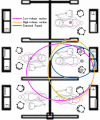Novel use of riboflavin as a fluorescent tracer in the dissemination of aerosol and splatter in an open operatory dental clinic
- PMID: 37000173
- PMCID: PMC10280617
- DOI: 10.1002/cre2.727
Novel use of riboflavin as a fluorescent tracer in the dissemination of aerosol and splatter in an open operatory dental clinic
Abstract
Objectives: The rapid spread of severe acute respiratory syndrome coronavirus 2 and the ensuing rise of the COVID-19 pandemic have impacted healthcare unprecedentedly. With the scarcity of available resources, including healthcare providers themselves, novel methods for tracking aerosol and splatter in real time are required to alleviate demand and increase safety. This study evaluates the utility of riboflavin (vitamin B2 ) as a tracer for splatter/aerosol distribution from ultrasonic scaling in an open operatory clinic.
Material and methods: In two experimental designs, ultrasonic scaling was performed on 18 volunteers or simulated on a manikin. Riboflavin was introduced into the irrigation system, and aerosol and splatter dissemination were evaluated for both experimental designs.
Results: Ultrasonic scaling utilizing riboflavin solution, in volunteers and manikins, leads to observable particle fluorescence under UV light. Contamination distribution varied across the different suction methods and between the volunteer and manikin trials. Nearly all observed incidences of contamination occurred within the operatory in use.
Conclusions: Riboflavin can be used with minimal risk during dental procedures and allows for the detection of droplet spread in clinical settings in real time.
Keywords: COVID-19; dental; infection control; riboflavin.
© 2023 The Authors. Clinical and Experimental Dental Research published by John Wiley & Sons Ltd.
Conflict of interest statement
The authors declare no conflict of interest.
Figures




Similar articles
-
Evaluating contaminated dental aerosol and splatter in an open plan clinic environment: Implications for the COVID-19 pandemic.J Dent. 2021 Feb;105:103565. doi: 10.1016/j.jdent.2020.103565. Epub 2021 Jan 6. J Dent. 2021. PMID: 33359041 Free PMC article.
-
Simulated and clinical aerosol spread in common periodontal aerosol-generating procedures.Clin Oral Investig. 2022 Sep;26(9):5751-5762. doi: 10.1007/s00784-022-04532-8. Epub 2022 May 17. Clin Oral Investig. 2022. PMID: 35581347 Free PMC article.
-
Reduction of aerosols and splatter generated during ultrasonic scaling by adding food-grade thickeners to coolants: an in-vitro study.Clin Oral Investig. 2022 Mar;26(3):2863-2872. doi: 10.1007/s00784-021-04265-0. Epub 2021 Nov 16. Clin Oral Investig. 2022. PMID: 34783913 Free PMC article.
-
A systematic review of droplet and aerosol generation in dentistry.J Dent. 2021 Feb;105:103556. doi: 10.1016/j.jdent.2020.103556. Epub 2020 Dec 23. J Dent. 2021. PMID: 33359043 Free PMC article.
-
Redefining aerosol in dentistry during COVID-19 pandemic.Dent Res J (Isfahan). 2022 Jul 18;19:53. eCollection 2022. Dent Res J (Isfahan). 2022. PMID: 36159064 Free PMC article. Review.
Cited by
-
Effectiveness of interventions to reduce aerosol generation in dental environments: A systematic review.Prev Med Rep. 2023 Aug 25;35:102383. doi: 10.1016/j.pmedr.2023.102383. eCollection 2023 Oct. Prev Med Rep. 2023. PMID: 37680854 Free PMC article. Review.
References
-
- Allison, J. R. , Currie, C. C. , Edwards, D. C. , Bowes, C. , Coulter, J. , Pickering, K. , Kozhevnikova, E. , Durham, J. , Nile, C. J. , Jakubovics, N. , Rostami, N. , & Holliday, R. (2021). Evaluating aerosol and splatter following dental procedures: Addressing new challenges for oral health care and rehabilitation. Journal of Oral Rehabilitation, 48(1), 61–72. 10.1111/joor.13098 - DOI - PMC - PubMed
-
- CDC . (2003). Guidelines for infection control in dental health‐care settings—2003. Morbidity and Mortality Weekly Report, 52(RR‐17), 1–61. - PubMed
Publication types
MeSH terms
Substances
LinkOut - more resources
Full Text Sources
Medical

